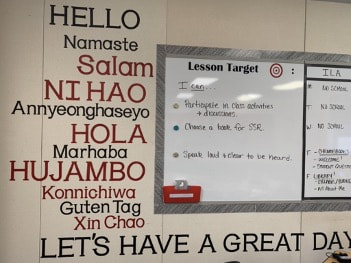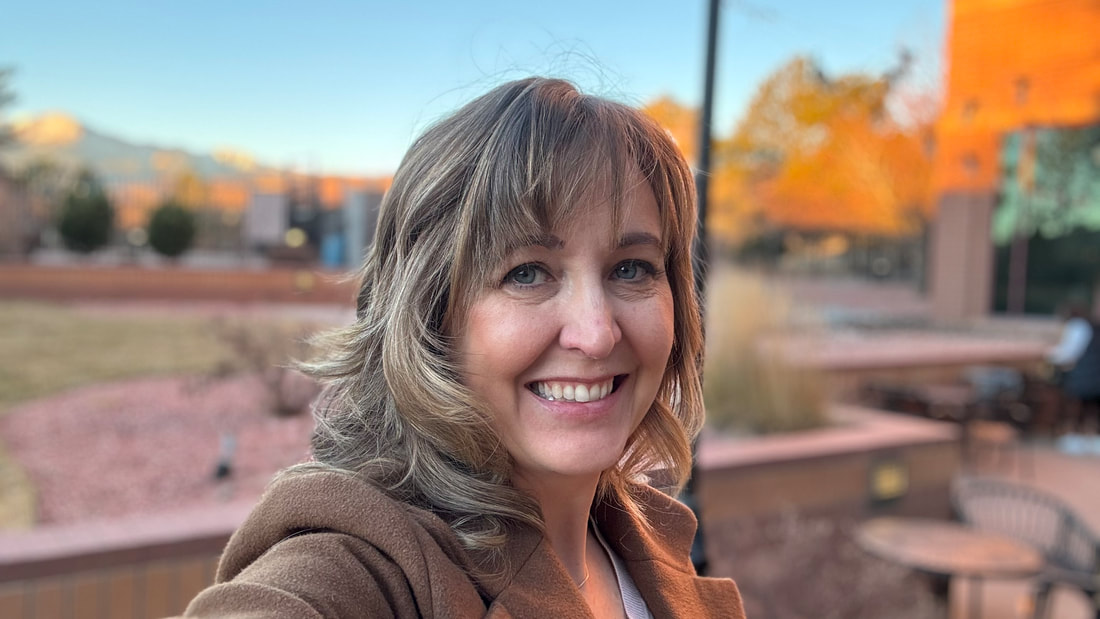|
I'd like to highlight two teachers who used their walls very effectively to welcome new students who were from different cultures than them. One ILA teacher at Fowler Middle School put the phonetic spelling for "welcome" in the languages of her new students on her wall. This allowed students who did not speak those languages to greet the newcomers in their home language. Often, teachers will ask me: What can I do to help newcomers feel safe enough to speak out in class? Sometimes I tell them: that it's not about what you train the new students to do, it's about what you train the "old" students to do: teach them how to welcome others from another culture. We, teachers, love to put our time, effort, energy, and money into creating a welcoming environment for our students on the first day of school. Nevertheless, no matter how “cute” and creative the decoration becomes, the physical design of our classrooms often unwittingly becomes an extension of our worldview and dominant culture (Hammond: 2015:19). Well-meaning teachers look for ways to decorate their rooms in ways that connect with and represent the diverse cultures of their students. This is becoming easier and easier to achieve with the wealth of culturally diverse resources in education. Yet, a cultural disconnect may still remain.
One teacher commented to me: “I am really trying hard to connect with the culture of my students. I even put up LatinX heroes for them in the classroom, like Frida Kahlo! But guess what - they didn’t even know who Frida Kahlo was!” This example illustrates the importance of discovering the students’ stories and the assets of their particular aesthetic or culture. Perhaps the artists that they admire are more in line with “Bad Bunny” and “Becky G,” and the only to find this out is through the practice of “noticing” (which we will discuss in more depth in chapter five (“Show the Student She is Seen”). In the meantime, this problem is mediated by the teacher taking a personal interest in the artists and figures from the cultures of her students. Instead of guessing who the students will like, the teacher highlights the artistry of someone she herself appreciates. This is so much more authentic (and children can sniff out inauthenticity better than anyone). I have seen a first-year teacher do this very effectively with his “hero wall.” When a student points to Kendrick Lamar, and says: “Who is that?” The teacher responds with: “Oh, he’s a master storyteller with a prophetic voice for our generation,” rather than: “he’s a black rapper from Compton, I put him up because I thought you might like him.” When students realize that the representation is personal to the teacher, this not only creates a connection with the teacher: “He is like me,” but it affirms the assets and innate beauty in the student’s own culture. World Cup fervor came on strong last spring. In my own house, there were lots of hoots and hollers and teenage boys with their t-shirts over their heads flying around the living room (I'll never understand this fútbol tradition. My cousin from Panama who plays soccer for a US university tried to explain it to me. "That's just what you do," he said. Anyway, I knew I had to leverage this excitement in my own ESL classroom, where "football" meant something very different from the way most understood "football" in Texas. Here's what we did: 1. Pick an engaging photo (from Google Images, ahead of time). It had to have Messi or Ronaldo in it (of course). 2. As a class, I asked students to list the nouns (or things) they saw in the photo. Some of these words they knew: "leg." Some of the words they didn't know: "That thing he wears here (points to leg), up high to protect" Me: "Sock?" Student: "No, not exactly..." Me: "Shin guard?" Student: "Yes! That's it." Students provided the words (with help, sometimes). I wrote them on the board because this group of newcomers did not know how to spell the majority of the words. 3. Then we did the same thing with verbs and adjectives. This is called the "Picture Word Inductive" Model, and Valentina Gonzalez gives a beautiful description of it here. Here's what came out of it:There are two main objectives in this writing prompt: (1) how to convert dialogue bubbles to properly punctuated dialogue on the page. (2) How to make inferences about characters' feelings.
This page comes from the popular graphic novel, "New Kid." Flipgrid is a great tool for students to take ownership of their speaking. Teachers can create a prompt on the site, determine how long they would like students to speak for (perhaps a minute), and include a visual to get the conversation going. I often made my own model Flipgrid video so that students could see the level of academic vocabulary I was expecting. It also helped me to see how many "takes" students might need to publish a video they feel comfortable with other students seeing. (This was sometimes a hard ask for middle school students!) One thing that helped is that I asked them to script out their responses, and then focus on reading their script into the camera. This helped them to focus on pronunciation and not to worry so much about what they looked like as they spoke extemporaneously.
Students would then engage with other students via flip grid videos, using sentence stems and targeted language: "Your argument that technology creates more harm than good was very persuasive, however...." Finally, I ask students to re-watch their own video and rate their own speaking with a rubric of student-friendly rubric of the proficiency level descriptors. Then make a "smart goal" of where they want to grow in their speaking ability. This entire activity is very involved, but it really turns the ownership over growing in their "CALPS" (Cognitive Academic Language Proficiency) over to the students. 5. - Google translate's function that connects your phone to the students' laptop
4. - CHAT GPT 3. - Say Hi 2. - Talking Points 1. - Youtube videos in heritage language (to build background knowledge) What have you found? |
AuthorElise White Diaz is an Educational Consultant with Seidlitz Education, specializing in trauma-informed multilingual education. CategoriesArchives
July 2024
|









 RSS Feed
RSS Feed
